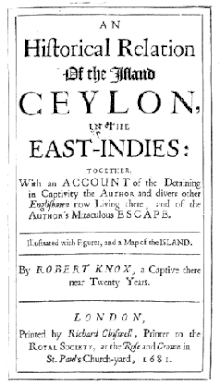An Historical Relation of the Island Ceylon

First edition
|
|
| Author | Robert Knox |
|---|---|
| Country | England |
| Language | English |
| Subject | History, ethnography |
| Genre | Non-fiction |
| Publisher | Richard Chiswell |
|
Publication date
|
1681 |
| Media type | |
An Historical Relation of the Island Ceylon together With somewhat Concerning Severall Remarkable passages of my life that hath hapned since my Deliverance out of Captivity is a book written by the English trader and sailor Robert Knox in 1681. It describes his experiences some years earlier on the South Asian island now best known as Sri Lanka. It provides one of the most important contemporary accounts of 17th century Ceylonese life.
Knox spent 19 years on Ceylon after being taken prisoner by King Râjasimha II. He survived by knitting caps, selling goods and lending rice and corn. He finally escaped with one companion in 1679 and reached Arippu, a Dutch settlement on the north-west coast of the island, from where he was able to return to England in 1680.
The book was written during the voyage to England. It came to the attention of Knox's employers, the directors of the British East India Company, who recommended its publication. The historian and biographer John Strype, Knox's cousin, helped him to prepare the book for publication with the encouragement of the natural philosopher and polymath Robert Hooke. It was printed by Richard Chiswell, the printer to the Royal Society, under the imprimaturs of the Society and the Company. When the book was published in 1681 it was widely read and was translated in Knox's lifetime into German (1689), Dutch (1692) and French (1693) editions. It made Knox internationally famous and was a major influence on the works of Daniel Defoe; Robinson Crusoe and the later Captain Singleton both draw on the experiences of Knox.
The Relation has a wider literary importance in influencing the development of the English novel. Knox uses direct and idiomatic language to provide detailed descriptions of the factual reality that he saw during his time on Ceylon. He paints a portrait of himself as a practical, self-sufficient and robust individual, very much like Defoe's shipwrecked mariner. The book is of fundamental importance as a source for the economic history and anthropology of Ceylon during this period due to the objectivity and detail of the text, in which Knox provides closely observed descriptions of Sinhalese topography, economic and social life, cultural characteristics and conditions in the kingdom of Kandy. It is divided into four parts; the first three describe the kingdom of Kandy, and the final part details Knox's escape from captivity.
...
Wikipedia
